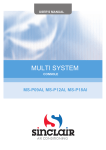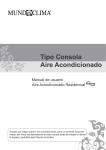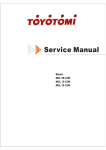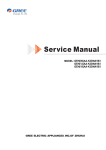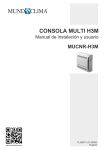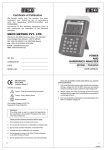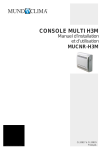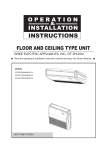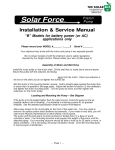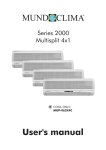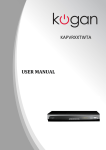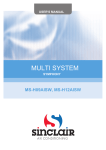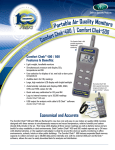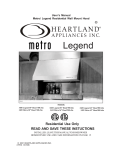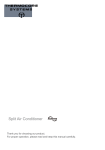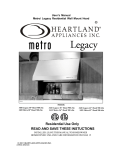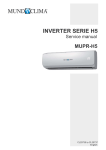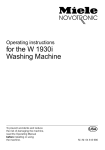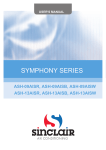Download Installation of indoor unit
Transcript
MULTISPLIT CONSOLE H3M Installation & user's manual MUCNR-H3M www.mundoclima.com CL20827 to CL20829 English Contents CONTENTS 1. User' s manual ......................................................................................................................................... 3 2. Installation manual ................................................................................................................................. 17 Thank you for selecting our products One of the benefits awaiting you with our room air conditioner is not only comfort of life but also good health. This operation instruction brings you the many omfort and technological features your unit has to offer. In addition, it provides you vital information about maintenance, service and economical operating. Take the next few minutes to discover how to get your comfort and economy of the operation from your new room air conditioner. The figures in this manual may be different with the material objects, please refer to the material objects for reference. This appliance is not intended for use by persons (including children) with reduced physical , sensory or mental capabilities or lack of experience and knowledge,unless they have been given supervision or instruction concerning use of the appliance by a person responsible for their safety. Children should be supervised to ensure that they do not play with the appliance. External static pressures at the appliance was tested is 0 Pa Fuse link: T250 V; 3.15 A Contents USER' S MANUAL 1. Part names and their functions ............................................................................................................... 4 2. How to use the remote control to operate the unit ................................................................................. 5 3. Maintenance ........................................................................................................................................ 10 4. Operating guide ................................................................................................................................... 13 5. Usage tips ............................................................................................................................................ 14 6. Precautions .......................................................................................................................................... 15 7. Checking before contact the service man ............................................................................................ 16 1 Part names and their functions USER' S MANUAL INDOOR UNIT 1 2 6 3 3 8 9 11 10 12 13 14 7 4 15 2 CAUTION Before opening the front panel, be sure to stop the operation and turn the breaker OFF. Do not touch the metal parts on the inside of the indoor unit, as it may result in injury. 1. Titanium Apatite Photocatalytic Air-Purifying Filter: • These filters are attached to the inside of the air filters. 2. Air outlet 3. Display 4. Front panel 5. Louvers (vertical blades) 5 Air outlet selection switch • This setting blows air from upper outlet only. • This setting automatically decides a blow pattern depending on mode and conditions. 16 • This setting is recommended. 17 • The unit is shipped from the factory with this setting. • The louvers are inside of the air outlet. 6. Air inlet 7. Air filter 8. Flap (horizontal blade) 9. Cool mode lamp 10. Heat mode lamp 11. Dry mode lamp 12. Run lamp 13. LED display 14. Indoor Unit ON/OFF switch: Opening the Front Panel Indoor unit wiring terminal N(1) 2 BU BK 3 BN YELLOW/ GREEN • Push this switch once to start operation. Push once again to stop it. • The operation mode refers to the following table. Model Mode COOLING COOL ONLY Temperature Air flow rate setting 25℃ AUTO HEAT 25℃ AUTO AUTO PUMP • This switch is useful when the remote controller is missing. 15.Signal receiver: • It receives signals from the remote controller. • When the unit receives a signal, you will hear a short beep. •Settings changed.....beep 16.Air outlet selection switch 17.Room temperature sensor: •It senses the air temperature around the unit. NOTE: ① If the supply cord is damaged, it must be replaced by the manufacturer or its service agent or a similarly qualified person in order to avoid a hazard. ② The appliance shall be installed in accordance with national wiring regulations. ③ An all-pole disconnection switch having a contact separation of at least 3mm in all polesshould be connected in fixed wiring. For models with a power plug, make sure the plugis within reach after installation. 2 How to use the remote control to operate the unit USER' S MANUAL Remote Controller Description 1 ON/OFF Press it to start or stop operation. 2 - : Press it to decrease temperature setting. 3 + : Press it to increase temperature setting. 4 MODE Press it to select operation mode (AUTO/COOL/DRY/FAN/HEAT). 5 FAN Press it to set fan speed. 1 6 SWING Press it set swing angle. 3 2 7 8 I FEEL / Press it to set HEALTH or AIR function. 4 5 9 SLEEP 6 7 10 TEMP 8 9 11 QUIET 10 11 12 13 14 16 15 Press it to set QUIET function. 12 CLOCK Press it set clock. 13 T-ON T-OFF Press it to set auto-off /auto-on timer. 14 TURBO 15 LIGHT Press it to turn on/off the light. 16 X-FAN How to use the remote control to operate the unit USER' S MANUAL Remote Controller Description 1 ON/OFF : Press this button to turn on the unit .Press this button again to turn off the unit. 2 Press this button to decrease set temperature. Holding it down above 2 seconds rapidly decreases set temperature. In AUTO mode, set temperature is not adjustable. 3 +: Press this button to increase set temperature.Holding it down above 2 seconds rapidly increases set temperature. In AUTO mode, set temperature is not adjustable. 4 MODE : Each time you press this button,a mode is selected in a sequence that goes from AUTO, COOL,DRY, FAN,and HEAT *, as the following: AUTO COOL DRY FAN HEAT * *Note:Only for models with heating function. After energization, AUTO mode is defaulted. In AUTO mode, the set temperature will not be displayed on the LED of the indoor, and the unit will automatically select the suitable operation mode in accordance with the room temperature to make indoor room comfortable. 5 FAN : This button is used for setting Fan Speed in the sequence that goes from AUTO, , then back to Auto. to , , , Auto Low speed Low-Medium speed Medium speed Medium-High speed 6 High speed SWING: Press this button to set up &down swing angle, which circularly changes as below: OFF This remote controller is universal . If any command out the command as , or is sent out, the unit will carry indicates the guide louver swings as: 7 I FEEL: Press this button to turn on I FEEL function. The unit automatically adjust temperature according to the sensed temperature. Press this button again to cancel I FEEL function. How to use the remote control to operate the unit 8 9 ● ● ● ● ● USER' S MANUAL / Press this button to achieve the on and off of healthy and scavenging functions in operation status. Press this button for the first time to start scavenging function; LCD displays“ ”. Press the button for the second time to start healthy and scavenging functions simultaneously; LCD displays“ ” and “ ” . Press this button for the third time to quit healthy and scavenging functions simultaneously. Press the button for the fourth time to start healthy function; LCD display “ ” . Press this button again to repeat the operation above. SLEEP: ), Sleep 2 ( ),Sleep 3 ( ) and cancel the Sleep, Press this button, can select Sleep 1 ( circulate between these, after electrified, Sleep Cancel is defaulted. Sleep 1 is Sleep mode 1, in Cool, Dehumidify modes: sleep status after run for one hour, the main unit setting temperature will increase 1 ℃,setting temperature increased 2℃, the unit will run at this setting temperature; In Heat mode: sleep status after run for one hour, the setting temperature will decrease 1 ℃, 2 hours, setting temperature will decrease 2 ℃, then the unit will run at this setting temperature. Sleep 2 is sleep mode 2, that is air conditioner will run according to the presetting a group of sleep temperature curve. Sleep 3- the sleep curve setting under Sleep mode by DIY: (1) Under Sleep 3 mode, press "Turbo" button for a long time, remote control enters into user individuation sleep setting status, at this time, the time of remote control will display "1 hour ", the setting temperature "88" will display the corresponding temperature of last setting sleep curve and blink (The first entering will display according to the initial curve setting value of original factory); (2) Adjust "+" and "-" button, could change the corresponding setting temperature, after adjusted, press "Trubo "button for confirmation; (3) At this time, 1 hour will be automatically increased at the timer postion on the remote control, (that are "2 hours " or "3 hours " or "8 hours "), the place of setting temperature "88" will display the corresponding temperature of last setting sleep curve and blink; (4) Repeat the above step (2) ~ (3) operation, until 8 hours temperature setting finished, sleep curve setting finished, at this time, the remote control will resume the original timer display; temperature display will resume to original setting temperature. Sleep3- the sleep curve setting under SLEEP mode by DIY could be inquired: The user could accord to sleep curve setting method to inquire the presetting sleep curve, enter into user individuation sleep setting status, but do not change the temperature, press "Turbo" button directly for confirmation. Note: In the above presetting or enquiry procedure, if continuously within10s, there is no button pressed, the sleep curve setting within10s, there is no button pressed, the sleep curve setting status will be automatically quit and resume to display the original displaying. In the presetting or enquiry procedure, press "ON/OFF" button, "Mode" button, "Timer"button or "Sleep" button, the sleep curve setting or enquiry status will quit similarly. 10 TEMP: Press this button, could select displaying the indoor setting temperature or indoor ambient temperature.When the indoor unit firstly power on it will display the setting temperature, if the temperature's displaying status is changed from other status to" ",displays the ambient temperature, 5s later or within 5s, it receives other remote control signal that will return to display the setting temperature. if the users haven't set up the temperature displaying status,that will display the setting temperature. How to use the remote control to operate the unit USER' S MANUAL 11 QUIET: Press this button, the Quiet status is under the Auto Quiet mode (display " " and "Auto" signal) and Quiet mode (display " " singal) and Quiet OFF (there is no signal of " " displayed), after powered on, the Quiet OFF is defaulted. Note: the Quiet function cannot be set up in Fan and Dry mode;Under the Quiet mode (Display " " signal), the fan speed is not available. 12 CLOCK : Press CLOCK button, blinking . Within 5 seconds,pressing + or - button adjusts the present time. Holding down either button above 2 seconds increases or decreases the time by 1 minute every 0.5 second and then by 10 minutes every 0.5 second. During blinking after setting, press CLOCK button again to confirm the setting,and then will be constantly displayed. 13 T-ON / T-OFF: Press T-ON button to initiate the auto-ON timer. To cancel the auto-timer program, simply press this button again. After press of this button, disappears and "ON "blinks .00:00 is displayed for ON time setting.Within 5 seconds,press + or - butt on to adjust the time value.Every press of either button changes the time setting by 1minute. Holding down either button rapidly changes the time setting by 1 minute and then 10 minutes.Within 5 Seconds after setting,press TIMER ON button to confirm. Press T-OFF button to initiate the auto-off timer. To cancel the auto-timer program, simply press the button again.TIMER OFF setting is the same as TIMER ON. 14 TURBO: Press this button to activate / deactivate the Turbo function which enables the unit to reach the preset temperature in the shortest time. In COOL mode, the unit will blow strong cooling air at super high fan speed. In HEAT mode, the unit will blow strong heating air at super high fan speed. 15 LIGHT: Press LIGHT button to turn on the display's light and press this button again to turn off the display 's light. If the light is turned on , is displayed. If the light is turned off, disappears. 16 X-FAN: Pressing X-FAN button in COOL or DRY mode,the icon is displayed and the indoor fan will continue operation for 10 minutes in order to dry the indoor unit even though you have turned off the unit. After energization, X-FAN OFF is defaulted. X-FAN is not available in AUTO,FAN or HEAT mode. 17 Combination of "+" and "-" buttons: About lock Press " + " and "-" buttons simultaneously to lock or unlock the keypad. If the remote controller is locked, is displayed. In this case, pressing any button, blinks three times. How to use the remote control to operate the unit USER' S MANUAL 18 Combination of "MODE " and "-" buttons : About switch between Fahrenheit and centigrade At unit OFF, press " MODE " and " -" buttons simultaneously to switch between ℃ and ℉ . 19 Combination of " TEMP " and "CLOCK" buttons : About Energy-saving Function Press "TEMP" and "CLOCK" simultaneously in COOL mode to start energy-saving function. Nixie tube on the remote controller displays "SE". Repeat the operation to quit the function. 20 Combination of " TEMP " and "CLOCK" buttons : About 8℃ Heating Function Press "TEMP" and "CLOCK" simultaneously in HEAT mode to start 8℃ Heating Function Nixie tube on the remote controller displays " " and a selected temperature of " 8℃" . (46℉ if Fahrenheit is adopted). Repeat the operation to quit the function. 21 About Back-lighting Function The unit lights for 4s when energizing for the first time, and 3s for later press. Replacement of Batteries 1.Remove the battery cover plate from the rear of the remote controller. (As shown in the figure) 2.Take out the old batteries. 3.Insert two new AAA1.5V dry batteries, and pay attention to the polarity. 4. Reinstall the battery cover plate. ★ Notes: ● When replacing the batteries, do not use old or different types of batteries, otherwise, it may cause malfunction. ● ● ● ● If the remote controller will not be used for a long time, please remove batteries to prevent batteries from leaking. The operation should be performed in its receiving range. It should be kept 1m away from the TV set or stereo sound sets. If the remote controller does not operate normally, please take the batteries out and reinsert them after 30 seconds.If it still can't operate properly, replace the batteries. Sketch map for replacing batteries 3 Maintenance USER' S MANUAL Before inspection and maintenance of the unit. PLEASE set power switch to “OFF” to cut off the power supply. 3.1 Units ● Indoor unit, Outdoor unit and Remote controller 1. Wipe them with dry soft cloth. ● Front panel 1. Open the front panel. Slide the two stoppers on the left and right sides inward until they click. 2. Remove the front panel. • Remove the string. • Allowing the front panel to fall forward will enable you to remove it. String 3. Clean the front panel. • Wipe it with a soft cloth soaked in water. • Only neutral detergent may be used. • In case of washing the front panel with water,dry it with cloth, dry it up in the shade after washing. 4. Attach the front panel. String • Insert the front panel into the grooves of the unit (3 places). • Attach the string to the right, inner-side of the front grille. • Close the panel slowly. Place front panel in grooves. CAUTION • Don’t touch the metal parts of the indoor unit. If you touch those parts, this may cause an injury. • When removing or attaching the front panel, use a robust and stable stool and watch your steps carefully. • When removing or attaching the front panel, support the panel securely with hand to prevent it from falling. • For cleaning, do not use hot water above 40°C, benzine, gasoline, thinner, nor other volatile oils, polishing compound, scrubbing brushes, nor other hand stuff. • After cleaning, make sure that the front panel is securely fixed. 3.2 Filters 1. Open the front panel. 2. Remove the air filter. • Press the claws on the right and left of the air filter down slightly, then pull upward. 3. Take off the Titanium Apatite Photocatalytic Air-Purifying Filter. • Hold the tabs of the frame, and remove the claws in 4 places. Maintenance USER' S MANUAL Titanium Apatite Photocatalytic Air-Purifying Filter 4. Clean or replace each filter. See figure. 5. Set the air filter and Titanium Apatite Photocatalytic Air-Purifying Filter as they were and close the front panel. • Operation without air filters may result in troubles as dust will accumulate inside the indoor unit. 6. Wash the air filters with water or clean them with vacuum cleaner. • If the dust does not come off easily, wash them with neutral detergent thinned with lukewarm water, then dry them up in the shade. • It is recommended to clean the air filters every week. 3.3 Titanium Apatite Photocatalytic Air-Purifying Filter The Titanium Apatite Photocatalytic Air-Purifying Filter can be renewed by washing it with water once every 6 months. We recommend replacing it once every 3 years. ● Maintenance 1. Vacuum dusts, and soak in warm water or water for about 10 to 15 minutes if dirt is heavy. 2. Do not remove filter from frame when washing with water. 3. After washing, shake off remaining water and dry in the shade. 4. Since the material is made out of paper, do not wring out the filter when removing water from it. ● Replacement Remove the tabs on the filter frame and replace with a new filter. • Dispose of the old filter as flammable waste. • Dispose of the old filter as flammable waste. NOTE • Operation with dirty filters: (1) cannot deodorize the air. (3) results in poor heating or cooling. (2) cannot clean the air. (4) may cause odour. Air filter Maintenance USER' S MANUAL Check Check that the base, stand and other fittings of the outdoor unit are not decayed or corroded. Check that nothing blocks the air inlets and the outlets of the indoor unit and the outdoor unit. Check that the drain comes smoothly out of the drain hose during COOL or DRY operation. • If no drain water is seen, water may be leaking from the indoor unit. Stop operation and consult the service shop if this is the case. 3. 4 Before a long idle period 1. Operate the “FAN only” for several hours on a fine day to dry out the inside. • Press “MODE” button and select “FAN” operation. • Press “ON/OFF” button and start operation. 2. After operation stops, turn off the breaker for the room air conditioner. 3. Clean the air filters and set them again. 4. Take out batteries from the remote controller. NOTE • When a multi outdoor unit is connected, make sure the heating operation is not used at the other room befure you use the fan operation. Working temperature range Indoor sideDB/WB(oC) Outdoor sideDB/WB(oC) Maximum cooling 32/23 48/- Maximum heating 27/--- 27/- The operating temperature range (outdoor temperature) for cooling unit is -15℃~48℃; for cooling and heating unit is -15℃~48℃. 4 Operating guide USER' S MANUAL Working principle and special functions for cooling Principle: Air conditioner absorbs heat in the room and transmit to outdoor and discharged, so that indoor ambient temperature decreased, its cooling capacity will increase or decrease by outdoor ambient temperature. Anti-freezing function: If the unit is running in COOL mode and in low temperature, there will be frost formed on the heat exchanger, when indoor heat exchanger temperature decreased below 0℃ , the indoor unit microcomputer will stop compressor running and protect the unit. Working principle and special functions for heating Principle: * Air conditioner absorbs heat from outdoor and transmits to indoor, in this way to increase room temperature. This is the heat pump heating principle, its heating capacity will be reduced due to outdoor temperature decrease. * If outdoor temperature becomes very low, please operate with other heating equipments. Defrosting: * When outdoor temperature is low but high humidity, after a long while running, frost will form on outdoor unit, that will effect the heating effect, at this time, the auto defrosting function will act, the heat running will stop for 8-10mins. * During the auto defrosting, the fan motors of indoor unit and outdoor unit will stop. * During the defrosting, the indoor indicator flashes, the outdoor unit may emit vapor, This is due to the defrosting, it isn't malfunction. * After defrosting finished,the heating will recover automatically. Anti-cool wind function: In Heat mode, the following three kinds of status, if indoor heat exchanger hasn't achieve certain temperature that indoor fan motor will not start, in this way to prevent blowing cool wind (within 3mins): 1. Heat operation just startedup. 2. After Auto defrosting operation is finished. 3. Heating under low temperature. The climate type of this unit is according to the nameplate. 5 U sage tips The temperature should not be set lower than what you need. This would result to increase energy cost. Clean the air filter every week for higher efficiency. Draw close curtains or close glass windows when cooling to prevent heat load from sun light which may cause more electricity cost. USER' S MANUAL To distribute cool air through out the roon, adjust air flow direction as shown by the arrows (see picture) to diffuse cool air. Close window and door while operating the unit to prevent leakage of cooled air to save energy. In case of ineffective ventilation,open the window to ventilate the room air once in a while but not too long since cooled air will be uselessly drained out. 6 Precautions USER' S MANUAL Check electrical system(voltage and frequency). Use the proper power supply indicated on the unit to operate the airconditioner and only fuses with specified capacity.Do not use pieces of wire instead of fuse. Turn off the airconditioner if ,while running, electricity interference occurs.If the unit is not to be used for a long time,cut off the power supply main switch. Do not insert objects into the air inlet or outlet when the airconditioner is running as it may cause damage or personal injury .Also pay special attention when children are around. Do not locate any obstacle against the air flow direction of indoor and outdoor unit. Inefficient performance or malfunction may result. Do not channel the air flow directly at people, especially infants,aged persons or patients. Do not locate a heater or any other heat source close to the unit.The heat may deform plastic parts. 7 Checking before contact the service man USER' S MANUAL Check the following before contact the service man.You may find the solution to your problems. After checking,if it still does not operate, please contact your local dealer. PROBLEM NO operation CAUSES Check if eletrical wire is damaged & check if breaker switch is still on. Check if the power supply is in order. Check if the timer switch is on or not. Check if the preset temperature is too high. The air conditioner runs but does not cool enough. Check if the sunlight shines directly into the room. Check if the door and window are opened. Check if there is anything obstructing the air discharge Check if the exhaust fan still operates Check if the air filter is dirty or clogged. Vapor or mist fume coming out of the unit while runing. Inoperative remote control. Hot air in the room mixes with cool air.This causes smoke fume. Loosened or disconnected wire between the unit and the display. Check if the batteries are inserted in correct directions. Check if the batteries are exhaused or not. Contents INSTALLATION MANUAL 1. Installation of indoor unit ...................................................................................................................... 18 2. Pipe preparation................................................................................................................................... 26 3. Refrigerant piping work ........................................................................................................................ 27 4. Routine check after installation ............................................................................................................ 28 1 Installation of indoor unit INSTALLATION MANUAL SELECTION OF INSTALLATION LOCATION. Half conceated Exposed ● Such a place where cool air can be distributed Concealed Mounting plate throughout the room. ● Such a place where condensation water is easily drained out. ● Such a place that can handle the weight of indoor unit. Molding ● Such a place which has easy access for maintenance. ● The appliance shall not be installed in the laundry. Grid(field supply) Floor lnstallation Wall Installation Location for securing the installation panel. THERE ARE 2 STYLES OF INSTALLATION. ● 700 CEILING TYPE 200 120 FLOOR TYPE Each type is similar to the other as follows; 644 220 Indoor unit 120 570 600 ● 0 30 16 1) the restrictions on installation specified in the indoor unit installation drawings are met. 2) both air intake and exhaust have clear paths met. 3) the unit is not in the path of direct sunlight. 4) the unit is away from the source of heat or steam. 5) there is no source of machine oil vapour (this may shorten indoor unit life). 6) cool(warm) air is circulated throughout the room. 7) the unit is away from electronic ignition type fluorwscent lamps 17 0 220 The indoor unit should be sited in a place where: Schematic drawing of hooks: 30 200 mm (inverter or rapid stert type) as they may shorten the remote controller range. 8) the unit is at least 1 metre away from any television or radio set(unit may cause interference with the picture or sound). INSTALLATION PAPER PLANK CAUTIONS FOR INSTALLATION WHERE AIR CONDITIONER TROUBLEIS LIABLE TOOCCUR. ● Where there is too much of oil area. ● Where it is acid base area. ● 150cm or more Where there is irregular electrical supply. Indoor Unit Installatio n Drawings 150cm or more The indoor unit may be mounted in any of the three styles shown here. 150cm or more 150cm or more 15cm or below from the floor Installation of indoor unit INSTALLATION MANUAL Refrigerant piping 1)Drill a hole ( 55mm in diameter ) in the spot indicated by the symbol in the illustration as below . 2)The location of the hole is different depending on which side of the pipe is taken out . 3)For piping ,see Connecting the refrigerant pipe ,under Indoor Unit Installation(1). 4)Allow space around the pipe for a easier indoor unit pipe connection. (Unit : mm) 60 45 Wall Left bottom piping 75 Right bottom piping 75 45 Right back piping Left/right piping 45 75 45 75 45 Left back piping CAUTION Min.allowable length The suggested shortest pipe length is 2.5m,in order to avoid noise from the outdoor unit and vibration. (Mechanical noise and vibration may occur depending on how the unit is installed and the environment in which it is used.) See the installation manual for the outdoor unit for the maximum pipe length. For multi-connections ,see the installation manual for the multi-outdoor unit. 350 wall 45 Refrigerant pipe 75 Floor Installation of indoor unit INSTALLATION MANUAL Boring a wal l hole and installing wal l embedded pipe For walls containing metal frame or metal board ,be sure to use a wall embedded pipe and wall cover in the feed-through hole to prevent water leakage. Be sure to caulk the gaps around the pipes with caulking material to prevent water leakage. 1)Bore a feed-through hole of 55mm in the wall so it has a down slope toward the outside. 2)Insert a wall pipe into the hole. 3)Insert a wall cover into wall pipe . 4)After completing refrigerant piping, wiring, and drain piping, caulk pipe hole gap Inside Wall embedded pipe (field supply) Wall hole cover Outside Caulking Φ55 Wall embedded pipe (field supply) with putty. Drain piping 1)Use commercial regid polyvinyl chloride pipe general VP 20 pipe, outer diameter 26mm, inner diameter 20mm for the drain pipe. 2)The drain hose (outer diameter 18mm at connecting end, 220mm long)is supplied with the indoor unit. Prepare the drain pipe picture below position. 3)The drain pipe should be inclined downward so that water will flow smoothly without any accumulation.(Should not be trap.) 4)Insert the drain hose to this depth so it won’t be pulled out of the drain pipe. 5)Insulate the indoor drain pipe with 10mm or more of insulation material to prevent condensation. 6)Remove the air filters and pour some water into the drain pan to check the water flows smoothly. 150 Must be no trap 100 Do not touch water 100 Drain hose Reducer 50mm or more Vinyl chloride drain pipe Installation of indoor unit INSTALLATION MANUAL Installing indoor unit 3 tabs 1.Preparation Casing Open the front panel, remove the 4 screws and dismount the front grille while pulling it forward. Front grille Follow the arrows to disengage the clasps on the front case to remove it. Follow the procedure below when removing the slit Front panel Remove front grille portions. For Moldings Remove 4 screws Open the front panel Remove the pillars. (Remove the slit portions on the bottom frame using nippers.) 2)Upper casing For Side Piping Remove the pillars. 1)Remove the 7screws. 2)Remove the upper casing (2 tabs). 3)Remove the left and right casings (2 tabs on each side ). 4)Remove the slit portions on the bottom frame and casings using nippers . 5)Return by following the steps in reverse order(3>2> 1). 3)Side casings 3)Side casings Remove 7 screws Casing Remove the pillar Bottom frame Casing Remove the pillar Remove the pillar 2.Installation Secure using 6 screws for floor installations.(Do not forget to secure to the rear wall.) For wall installations, secure the mounting plate using 5 screws and the indoor unit using 4 screws. Installation of indoor unit INSTALLATION MANUAL The mounting plate should be installed on a wall which can support the weight of the indoor unit. 1) Temporarily secure the mounting plate to the wall, make sure that the panel is completely level, and mark the boring points on the wall. 2) Secure the mounting plate to the wall with screws. Floor Installation Wall Installation Casing 200m m Molding 6screws 6screws 3) Once refrigerant piping and drain piping connections are complete, fill in the gap of the through hole with putty. A gap can lead to condensation on the refrigerant pipe, and drain pipe, and the entry of insects into the pipes. 4) Attach the front panel and front grille in their original positions once all connections are complete. Flaring the pipe end 1)Cut the pipe end with a pipe cutter. 2)Remove burrs with the cut surface facing downward so that the chips do not enter the pipe. 3)Fit the flare nut on the pipe. 4)Flare the pipe. 5)Check that the flaring is properly made. WARNING 1) 2) 3) 4) 5) DO not use mineral oil on flared part. Prevent mineral oil from getting into the system as this would reduce the lifetime of the units. Never use piping which had been used for previous installations. Only use parts which are delivered with the unit. Do never install a drier to this R410A unit in order to guarantee its lifetime. The drying material may dissolve and damage the system. 6) Incomplete flaring may cause refrigerant gas leakage. Flaring Set exactly at the position shown below Flare tool for R410A A Cut exactly at right angles Die Renove burrs A Conventional flare tool Clutch-type Clutch-type (Rigid-type) Wing-nut type (lmperial-type) 0-0.5mm 1.0-1.5mm 1.5-2.0mm Flare’s inner surface must be scratch-free The pipe end must be evenly flared in a perfect circle Make sure that the flare nut is fitted Installation of indoor unit INSTALLATION MANUAL Connecting the refrigerant pipe 1) Use torque wrenches when tightening the flare nuts to prevent damage to the flare nuts and gas leaks. Open-end wrench (fixed) Coat here with refrigeration oil Flare nut Wrench Connection pipe Indoor unit tubing 2) Align the centres of both flares and tighten the flares and tighten the flare nuts 3 or 4 turns by hand. Then tighten them fully with the torque wrenches. 3) To prevent gas leakage, apply refrigeration oil on both inner and outer surfaces in the flare. (Use refrigeration oil for R410A.) Flare nut tightening torque Gas side 09K/12K Liquid side 18K 3/8 inch 31-35 N.m 09K/12K/18K 1/2 inch 1/4 inch 50-55 N.m 15-20 N.m Be sure to place a cap. Caution on piping handling 1)Protect the open end of the pipe against dust and moisture. 2)All pipe bends should be as gentle as possible. Use a pipe bender for bending. If no flare cap is available,cover the flare mouth with tape to keep dirt or water out. (Bending radius should be 30 to 40mm or larger.) Inter-unit wiring Selection of copper and heat insulation materials When using commercial copper pipes and fittings, observe the following: 1)Insulation material: Polyethylene foam Heat transfer rate:0.041 to 0.052W/mK(0.035 to 0.045kca/(mh Refrigerant gas pipe’s surface temperature reaches 110 max. Choose heat insulation materials that will withstand this temperature. Gas pipe Liquid pipe Liquid pipe insulation Gas pipe insulstion Finising tape 2)Be sure to insulate both the gas and liquid piping and to provide insulation dimensions as below. Gas side 09K/12K O.D. 9.5mm Liquid side 18K O.D. 12.7mm Thickness 0.8mm Gas pipe thermal insulation 09K/12K O.D. 6.4mm I.D. 12-15mm Liquid pipe thermal insulation 18K I.D. 14-16mm Thickness 10mm Min. 3)Use separate thermal insulation pipes for gas and liquid refrigerant pipes. I.D. 8-10mm Installation of indoor unit INSTALLATION MANUAL Checking for gas leakage 1)Check for leakage of gas after air purging 2)See the sections on air purges and gas leak checks in the installation manual for the outdoor unit. Check for leakage here Apply soapy water and check carefully for leaking gas. wipe soapy water off after the check is complete. Attaching the connection pipe Attach the pipe after checking for gas leakage, described above. 1)Cut the insulated portion of the on-site piping, matching it up with the connecting portion. 2)Secure the slit on the refrigerant piping side with the butt joint on the auxiliary piping using the tape, making sure there are no gaps. 3)Wrap the slit and butt joint with the included insulation sheet, making sure there are no gaps. Refrigerant pipe Slit Refrigerant pipe Refrigerant pipe Slit Insulation sheet Tape Auxiliary pipe CAUTION 1)Insulate the joint of the pipes securely. Incomplete insulation may lead to water leakage. 2)Push the pipe inside so it does not place undue force on the front grille. Connecting the drain hose Insert the supplied C drain hose into the socket of the drain pan. Fully insert the drain hose until it adheres to a seat of the socket. Drain pan Seal Drain hose Drain pan Seal Installation of indoor unit INSTALLATION MANUAL Wiring With a Multi indoor unit, install as described in the installation manual supplied with the Multi outdoor unit. Live the sensor securing plate, remove the front metal plate cover, and connect the branch wiring to the terminal block. 1)Strip wire ends (15mm) 2)Mach wire colours with terminal numbers on indoor and outdoor unit’s terminal blocks and firmly screw wires to the corresponding terminals. 3)Connect the earth wires to the corresponding terminals. 4)Pull wires to make sure that they are securely latches up, then retain wires with wire retainer. Sensor securing plate Front metal plate cover Firmly secure wire retainer so that wires sustain no external stress. N(1) 2 3 Terminal block Electrical component box Wire retainer Use the specified wire type. Indoor unit Shape wires so that the front metal plate cover will fit securely. Firmly fix the wires with the terminal screws Outdoor unit When wire length exceeds 10m, use 2.0mmdiameter wires Firmly fix the wires with the terminal screws CAUTION 1)Do not use tapped wires, stranded wires, extensioncords, or starburst connections, as they may cause overheating, electrical shock, or fire. 2)Do not use locally purchased electrical parts inside the product. (Do not branch the power for the drain pump, etc, from the terminal block.) Doing so may cause electric shock or fire.) 2 Pipe preparation INSTALLATION MANUAL Cutting Tool Wrong Right 2.1 PIPE & ELECTRICAL WIRE CUTTING Sloped Cut Rough Cut Use cutting tools easily found in the market. Measure precisely both outer & inner pipe. Provide a little bit longer pipe than the measurement. Wire must be 1.5 m. longer than the refrigerant tube. Refrigerant Tube 2.2 REAMING Reamer Clean inside of the inner refrigerant tube. While reaming, the tube end must be on the top of the reamer to prevent any dust going back into the tube. Up side down position 0.5 mm. 2.3 FLARING THE PIPE END Flare both ends of the pipe with flaring kit by fitting the flare nut on the pipe before flaring.Set the die on the pipe so that pipe end is 0.5 mm. above top of the die. Check if the pipe end is even and pertectly round. Refrigerant Tube Uneven Slope 2.4 WIRE CONNECTION AND TAPE COVERING Flare Kit Poor skin 30-40 mm Cracked Uneven Thickness Low Pressure Refrigerant Tube (see the picture on the right side) Connecting Wire High Prseeure To indoor Unit Refrigerant Tube To Outdoor Unit 3 3. 1 Refrigerant piping work INSTALLATION MANUAL Select copper pipes for gas and liquid as informed in specific table(see the pipe table below) 3.2 For dust and moisture protection, before assembly of the pipe and its insulation,both end of the pipe must be covered. 3.3 Avoid pipe bending as much as possible.If it is necessary, the bending radius must be more than 3cm. or 4cm. Gas pipe and liquid pipe insulation depends upon copper pipe size and the insulation thickness = 3/8" GAS PIPE TABLE MODEL PIPE SIZE 9K 12K 3/8" 18K 3/8" 1/2" LIQUID PIPE TABLE MODEL PIPE SIZE 9K 12K 1/4" 18K 1/4" 1/4" Connecting Wire Liquid Pipe Gas Pipe Dia. Drain Pipe 1/2" Piping Tape 3.4 The connection between an indoor unit and an outdoor unit. Unscrew the flare nut for releasing pressure gas in the indoor unit.If there is no high pressure gas blowing out, it is the signal of a leaking indoor unit. Fit the flare nut to the liquid pipe.Flare the pipe's end with flare tool. Tighten both flare nuts into gas pipe and liquid pipe at the indoor unit with two holding spanners. 4 Routine check after installation INSTALLATION MANUAL Check after installation Items to be checked Possible malfunction Has it been fixed firmly? The unit may drop,shake or emit noise. Have you done the refrigerant leakage test? It may cause insufficient refrigerating capacity. Is heat insulation sufficient? It may cause condensation and dripping. Does the unit drain well? It may cause condensation and dripping. Is the voltage in accordance with the rated voltage marked on the nameplate? It may cause electric malfunction or damage the part. Is the electrical wiring and piping connection installed correctly and securely? It may cause electric malfunction or damage the part. Has the unit been connected to a secure earth connection? It may cause electrical leakage. Is the power cord specified? It may cause electric malfunction or damage the part. Has the inlet and outlet been covered? It may cause insufficient refrigerating capacity. Has the length of connection pipes and the refrigerant charge been record? The refrigerating capacity is not accurate Situation Notes: ASK FOR MORE INFORMATION Phone: (+34) 93 446 27 80 eMail: [email protected] TECHNICAL ASSISTANCE Phone: (+34) 93 652 53 57 www.mundoclima.com






























